Comparison of two theories of intergroup relations and its connection with the development of prejudice
VerifiedAdded on 2023/06/18
|8
|2495
|169
AI Summary
This report compares and analyzes the Authoritarian Personality Theory and Realistic Conflict Theory and their connection with the development of prejudice. It also discusses intergroup relations and their impact on society. The report concludes that these theories are important for the nation's growth and development.
Contribute Materials
Your contribution can guide someone’s learning journey. Share your
documents today.

PC5060
Secure Best Marks with AI Grader
Need help grading? Try our AI Grader for instant feedback on your assignments.
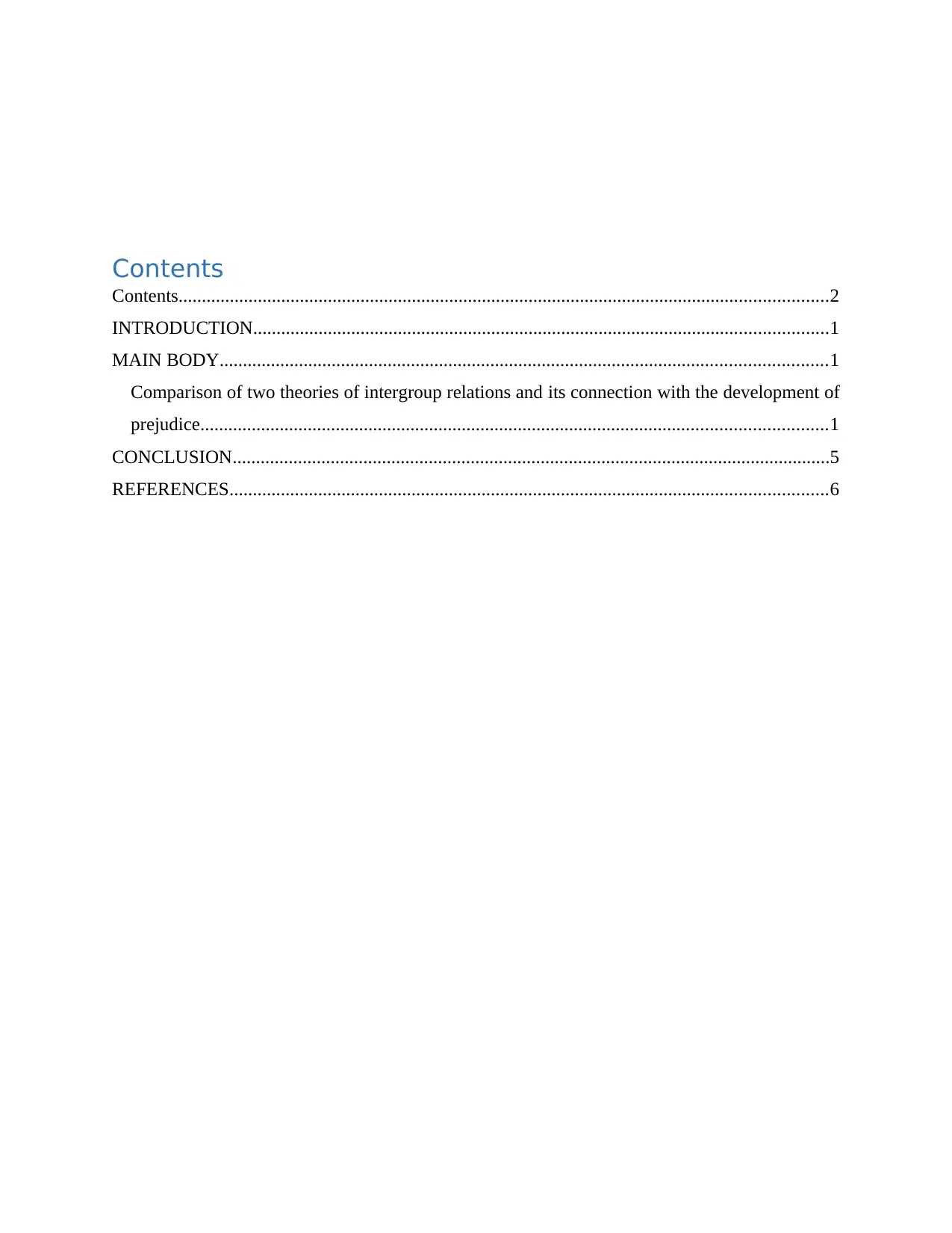
Contents
Contents...........................................................................................................................................2
INTRODUCTION...........................................................................................................................1
MAIN BODY..................................................................................................................................1
Comparison of two theories of intergroup relations and its connection with the development of
prejudice......................................................................................................................................1
CONCLUSION................................................................................................................................5
REFERENCES................................................................................................................................6
Contents...........................................................................................................................................2
INTRODUCTION...........................................................................................................................1
MAIN BODY..................................................................................................................................1
Comparison of two theories of intergroup relations and its connection with the development of
prejudice......................................................................................................................................1
CONCLUSION................................................................................................................................5
REFERENCES................................................................................................................................6
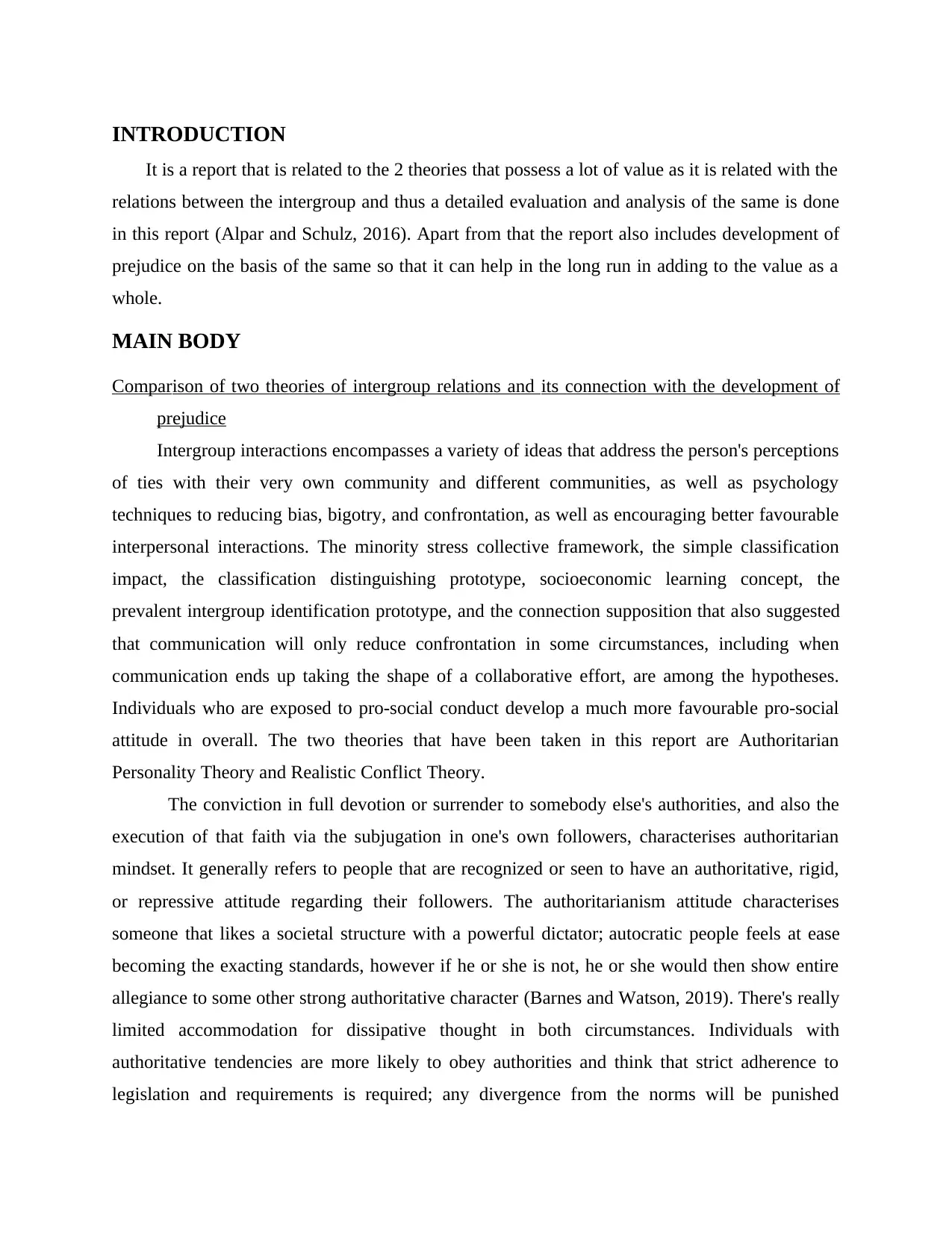
INTRODUCTION
It is a report that is related to the 2 theories that possess a lot of value as it is related with the
relations between the intergroup and thus a detailed evaluation and analysis of the same is done
in this report (Alpar and Schulz, 2016). Apart from that the report also includes development of
prejudice on the basis of the same so that it can help in the long run in adding to the value as a
whole.
MAIN BODY
Comparison of two theories of intergroup relations and its connection with the development of
prejudice
Intergroup interactions encompasses a variety of ideas that address the person's perceptions
of ties with their very own community and different communities, as well as psychology
techniques to reducing bias, bigotry, and confrontation, as well as encouraging better favourable
interpersonal interactions. The minority stress collective framework, the simple classification
impact, the classification distinguishing prototype, socioeconomic learning concept, the
prevalent intergroup identification prototype, and the connection supposition that also suggested
that communication will only reduce confrontation in some circumstances, including when
communication ends up taking the shape of a collaborative effort, are among the hypotheses.
Individuals who are exposed to pro-social conduct develop a much more favourable pro-social
attitude in overall. The two theories that have been taken in this report are Authoritarian
Personality Theory and Realistic Conflict Theory.
The conviction in full devotion or surrender to somebody else's authorities, and also the
execution of that faith via the subjugation in one's own followers, characterises authoritarian
mindset. It generally refers to people that are recognized or seen to have an authoritative, rigid,
or repressive attitude regarding their followers. The authoritarianism attitude characterises
someone that likes a societal structure with a powerful dictator; autocratic people feels at ease
becoming the exacting standards, however if he or she is not, he or she would then show entire
allegiance to some other strong authoritative character (Barnes and Watson, 2019). There's really
limited accommodation for dissipative thought in both circumstances. Individuals with
authoritative tendencies are more likely to obey authorities and think that strict adherence to
legislation and requirements is required; any divergence from the norms will be punished
It is a report that is related to the 2 theories that possess a lot of value as it is related with the
relations between the intergroup and thus a detailed evaluation and analysis of the same is done
in this report (Alpar and Schulz, 2016). Apart from that the report also includes development of
prejudice on the basis of the same so that it can help in the long run in adding to the value as a
whole.
MAIN BODY
Comparison of two theories of intergroup relations and its connection with the development of
prejudice
Intergroup interactions encompasses a variety of ideas that address the person's perceptions
of ties with their very own community and different communities, as well as psychology
techniques to reducing bias, bigotry, and confrontation, as well as encouraging better favourable
interpersonal interactions. The minority stress collective framework, the simple classification
impact, the classification distinguishing prototype, socioeconomic learning concept, the
prevalent intergroup identification prototype, and the connection supposition that also suggested
that communication will only reduce confrontation in some circumstances, including when
communication ends up taking the shape of a collaborative effort, are among the hypotheses.
Individuals who are exposed to pro-social conduct develop a much more favourable pro-social
attitude in overall. The two theories that have been taken in this report are Authoritarian
Personality Theory and Realistic Conflict Theory.
The conviction in full devotion or surrender to somebody else's authorities, and also the
execution of that faith via the subjugation in one's own followers, characterises authoritarian
mindset. It generally refers to people that are recognized or seen to have an authoritative, rigid,
or repressive attitude regarding their followers. The authoritarianism attitude characterises
someone that likes a societal structure with a powerful dictator; autocratic people feels at ease
becoming the exacting standards, however if he or she is not, he or she would then show entire
allegiance to some other strong authoritative character (Barnes and Watson, 2019). There's really
limited accommodation for dissipative thought in both circumstances. Individuals with
authoritative tendencies are more likely to obey authorities and think that strict adherence to
legislation and requirements is required; any divergence from the norms will be punished
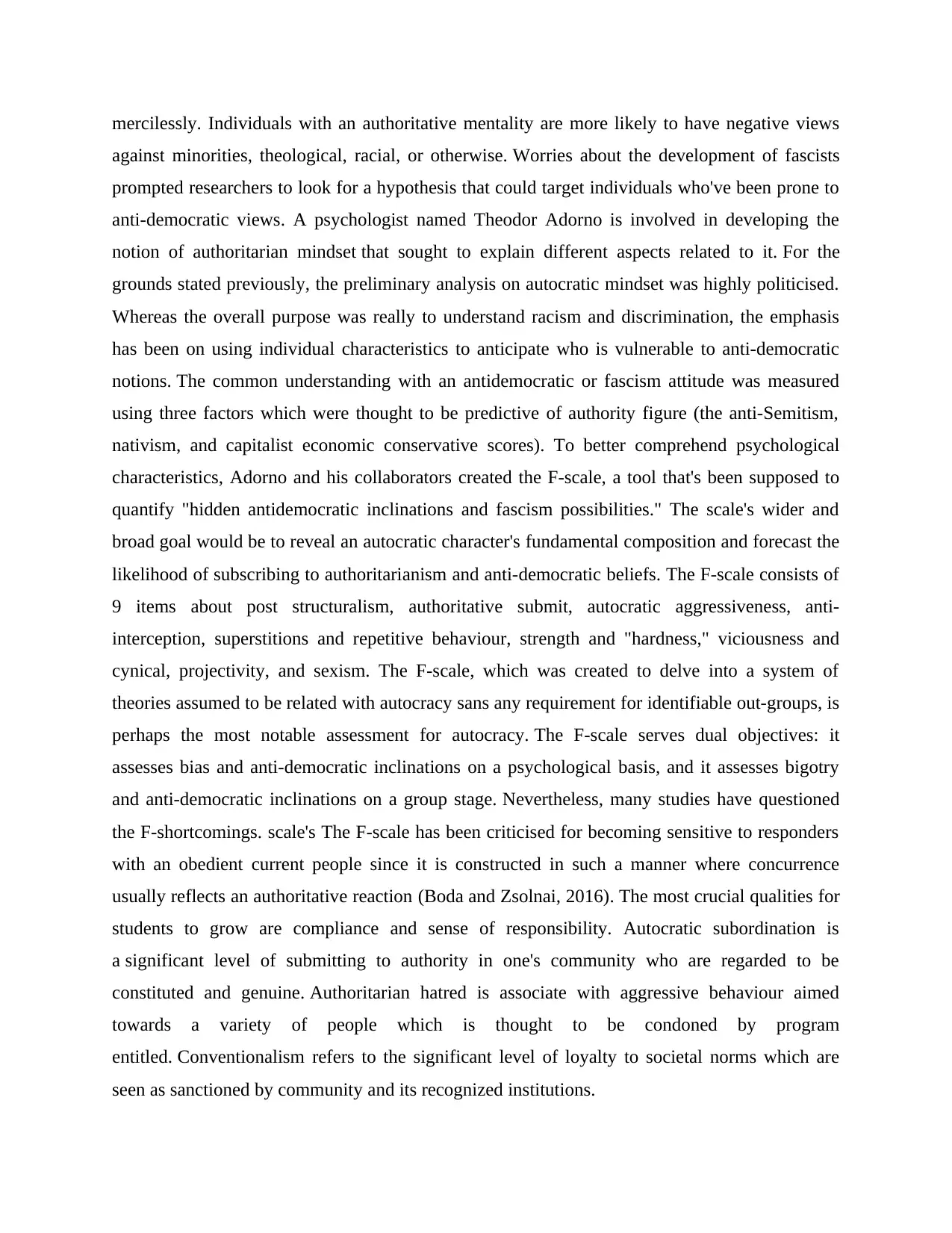
mercilessly. Individuals with an authoritative mentality are more likely to have negative views
against minorities, theological, racial, or otherwise. Worries about the development of fascists
prompted researchers to look for a hypothesis that could target individuals who've been prone to
anti-democratic views. A psychologist named Theodor Adorno is involved in developing the
notion of authoritarian mindset that sought to explain different aspects related to it. For the
grounds stated previously, the preliminary analysis on autocratic mindset was highly politicised.
Whereas the overall purpose was really to understand racism and discrimination, the emphasis
has been on using individual characteristics to anticipate who is vulnerable to anti-democratic
notions. The common understanding with an antidemocratic or fascism attitude was measured
using three factors which were thought to be predictive of authority figure (the anti-Semitism,
nativism, and capitalist economic conservative scores). To better comprehend psychological
characteristics, Adorno and his collaborators created the F-scale, a tool that's been supposed to
quantify "hidden antidemocratic inclinations and fascism possibilities." The scale's wider and
broad goal would be to reveal an autocratic character's fundamental composition and forecast the
likelihood of subscribing to authoritarianism and anti-democratic beliefs. The F-scale consists of
9 items about post structuralism, authoritative submit, autocratic aggressiveness, anti-
interception, superstitions and repetitive behaviour, strength and "hardness," viciousness and
cynical, projectivity, and sexism. The F-scale, which was created to delve into a system of
theories assumed to be related with autocracy sans any requirement for identifiable out-groups, is
perhaps the most notable assessment for autocracy. The F-scale serves dual objectives: it
assesses bias and anti-democratic inclinations on a psychological basis, and it assesses bigotry
and anti-democratic inclinations on a group stage. Nevertheless, many studies have questioned
the F-shortcomings. scale's The F-scale has been criticised for becoming sensitive to responders
with an obedient current people since it is constructed in such a manner where concurrence
usually reflects an authoritative reaction (Boda and Zsolnai, 2016). The most crucial qualities for
students to grow are compliance and sense of responsibility. Autocratic subordination is
a significant level of submitting to authority in one's community who are regarded to be
constituted and genuine. Authoritarian hatred is associate with aggressive behaviour aimed
towards a variety of people which is thought to be condoned by program
entitled. Conventionalism refers to the significant level of loyalty to societal norms which are
seen as sanctioned by community and its recognized institutions.
against minorities, theological, racial, or otherwise. Worries about the development of fascists
prompted researchers to look for a hypothesis that could target individuals who've been prone to
anti-democratic views. A psychologist named Theodor Adorno is involved in developing the
notion of authoritarian mindset that sought to explain different aspects related to it. For the
grounds stated previously, the preliminary analysis on autocratic mindset was highly politicised.
Whereas the overall purpose was really to understand racism and discrimination, the emphasis
has been on using individual characteristics to anticipate who is vulnerable to anti-democratic
notions. The common understanding with an antidemocratic or fascism attitude was measured
using three factors which were thought to be predictive of authority figure (the anti-Semitism,
nativism, and capitalist economic conservative scores). To better comprehend psychological
characteristics, Adorno and his collaborators created the F-scale, a tool that's been supposed to
quantify "hidden antidemocratic inclinations and fascism possibilities." The scale's wider and
broad goal would be to reveal an autocratic character's fundamental composition and forecast the
likelihood of subscribing to authoritarianism and anti-democratic beliefs. The F-scale consists of
9 items about post structuralism, authoritative submit, autocratic aggressiveness, anti-
interception, superstitions and repetitive behaviour, strength and "hardness," viciousness and
cynical, projectivity, and sexism. The F-scale, which was created to delve into a system of
theories assumed to be related with autocracy sans any requirement for identifiable out-groups, is
perhaps the most notable assessment for autocracy. The F-scale serves dual objectives: it
assesses bias and anti-democratic inclinations on a psychological basis, and it assesses bigotry
and anti-democratic inclinations on a group stage. Nevertheless, many studies have questioned
the F-shortcomings. scale's The F-scale has been criticised for becoming sensitive to responders
with an obedient current people since it is constructed in such a manner where concurrence
usually reflects an authoritative reaction (Boda and Zsolnai, 2016). The most crucial qualities for
students to grow are compliance and sense of responsibility. Autocratic subordination is
a significant level of submitting to authority in one's community who are regarded to be
constituted and genuine. Authoritarian hatred is associate with aggressive behaviour aimed
towards a variety of people which is thought to be condoned by program
entitled. Conventionalism refers to the significant level of loyalty to societal norms which are
seen as sanctioned by community and its recognized institutions.
Paraphrase This Document
Need a fresh take? Get an instant paraphrase of this document with our AI Paraphraser

According to the realistic conflict hypothesis, anytime 2 or multiple subgroups compete
for the identical scarce funds; this should result in confrontation, unfavourable perceptions and
attitudes, and discriminating. The clash may increase enmity between the parties, maybe
resulting in a long-term feud. In instances when two or more people are pursuing specific career,
friction, unfavourable attitudes and ideas, and prejudice among subgroups could theoretically be
eliminated. Super ordinate objectives are favourite spots objectives which can only be achieved
if two or more organisations work together. The model postulates how intergroup animosity
could develop as a consequence of competing aims and struggle for available budgets, as well as
the bigotry forward towards the out-group which often accompanies intergroup antagonism.
Muzafer Sherif and Carolyn Wood Sherif's Robbers Cave Experiment from 1954 is among the
most well-known RCT experiments. The Sherifs' research focused on intergroup behaviour and
was done over three weeks in a 200-acre summer camp in Robbers Cave State Park, Oklahoma.
Scientists pretended to be camping counsellors and observed 22 eleven- and twelve-year-old
children that had never interacted before but shared different histories. There were 3 phases to
the trial were like the very first phase was in-group development, in which students are divided
into 2 nearly comparable subgroups depending on their commonalities when they arrived. Every
side remained completely oblivious of the existence of another. The frictional round has been the
next round, in which the teams competed against one another in different camping sports. The
victors received valuable rewards (Brondoni, 2018). All subgroups developed unfavourable
thoughts and actions toward the out-group as a result of this. The integrating phase has been the
3rd phase. Conflicts amongst the subgroups was minimised throughout this phase by assigning
teamwork-based activities which involve intergroup interaction. Personal characteristics are
neither essential nor important for the occurrence of intergroup confrontation. Whenever
communities strive for commodities which just one party could obtain, hostile and
confrontational sentiments toward the out-group emerge. Hateful comments cannot be reduced
only by interaction with an out-group. Except in the existence of identifying and managing risk
which fosters unified, social cooperation could subgroup tension be decreased together with
good intergroup contact. Realistic Conflicts Theories (RCT) is a sociological paradigm which
tries to understand whether people are developing bias, unfavourable preconceptions, and
hostility against people from different socioeconomic groupings. Aspects such as financial class,
nationality, and distinct habits are frequently used to divide items into categories. RCT is a
for the identical scarce funds; this should result in confrontation, unfavourable perceptions and
attitudes, and discriminating. The clash may increase enmity between the parties, maybe
resulting in a long-term feud. In instances when two or more people are pursuing specific career,
friction, unfavourable attitudes and ideas, and prejudice among subgroups could theoretically be
eliminated. Super ordinate objectives are favourite spots objectives which can only be achieved
if two or more organisations work together. The model postulates how intergroup animosity
could develop as a consequence of competing aims and struggle for available budgets, as well as
the bigotry forward towards the out-group which often accompanies intergroup antagonism.
Muzafer Sherif and Carolyn Wood Sherif's Robbers Cave Experiment from 1954 is among the
most well-known RCT experiments. The Sherifs' research focused on intergroup behaviour and
was done over three weeks in a 200-acre summer camp in Robbers Cave State Park, Oklahoma.
Scientists pretended to be camping counsellors and observed 22 eleven- and twelve-year-old
children that had never interacted before but shared different histories. There were 3 phases to
the trial were like the very first phase was in-group development, in which students are divided
into 2 nearly comparable subgroups depending on their commonalities when they arrived. Every
side remained completely oblivious of the existence of another. The frictional round has been the
next round, in which the teams competed against one another in different camping sports. The
victors received valuable rewards (Brondoni, 2018). All subgroups developed unfavourable
thoughts and actions toward the out-group as a result of this. The integrating phase has been the
3rd phase. Conflicts amongst the subgroups was minimised throughout this phase by assigning
teamwork-based activities which involve intergroup interaction. Personal characteristics are
neither essential nor important for the occurrence of intergroup confrontation. Whenever
communities strive for commodities which just one party could obtain, hostile and
confrontational sentiments toward the out-group emerge. Hateful comments cannot be reduced
only by interaction with an out-group. Except in the existence of identifying and managing risk
which fosters unified, social cooperation could subgroup tension be decreased together with
good intergroup contact. Realistic Conflicts Theories (RCT) is a sociological paradigm which
tries to understand whether people are developing bias, unfavourable preconceptions, and
hostility against people from different socioeconomic groupings. Aspects such as financial class,
nationality, and distinct habits are frequently used to divide items into categories. RCT is a
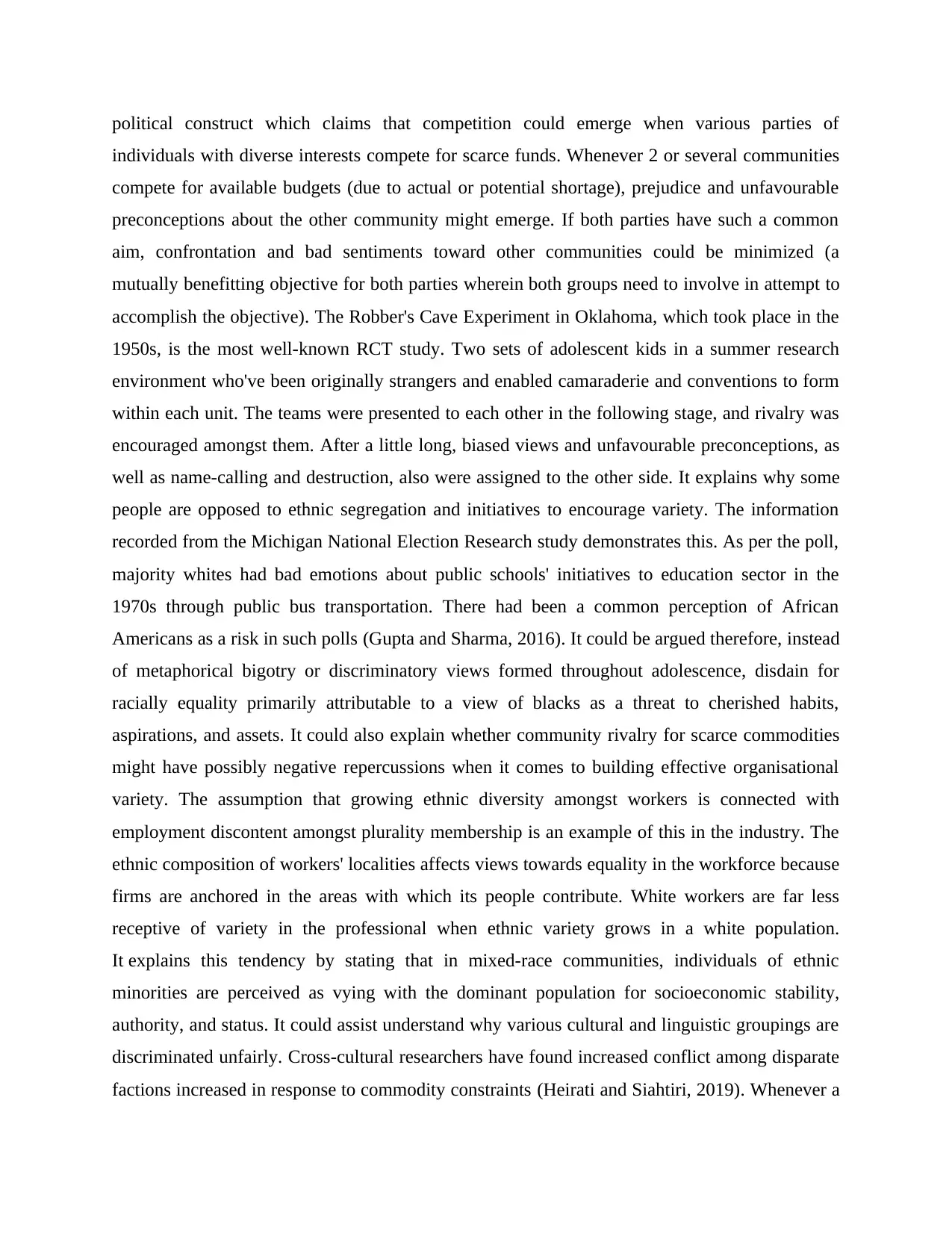
political construct which claims that competition could emerge when various parties of
individuals with diverse interests compete for scarce funds. Whenever 2 or several communities
compete for available budgets (due to actual or potential shortage), prejudice and unfavourable
preconceptions about the other community might emerge. If both parties have such a common
aim, confrontation and bad sentiments toward other communities could be minimized (a
mutually benefitting objective for both parties wherein both groups need to involve in attempt to
accomplish the objective). The Robber's Cave Experiment in Oklahoma, which took place in the
1950s, is the most well-known RCT study. Two sets of adolescent kids in a summer research
environment who've been originally strangers and enabled camaraderie and conventions to form
within each unit. The teams were presented to each other in the following stage, and rivalry was
encouraged amongst them. After a little long, biased views and unfavourable preconceptions, as
well as name-calling and destruction, also were assigned to the other side. It explains why some
people are opposed to ethnic segregation and initiatives to encourage variety. The information
recorded from the Michigan National Election Research study demonstrates this. As per the poll,
majority whites had bad emotions about public schools' initiatives to education sector in the
1970s through public bus transportation. There had been a common perception of African
Americans as a risk in such polls (Gupta and Sharma, 2016). It could be argued therefore, instead
of metaphorical bigotry or discriminatory views formed throughout adolescence, disdain for
racially equality primarily attributable to a view of blacks as a threat to cherished habits,
aspirations, and assets. It could also explain whether community rivalry for scarce commodities
might have possibly negative repercussions when it comes to building effective organisational
variety. The assumption that growing ethnic diversity amongst workers is connected with
employment discontent amongst plurality membership is an example of this in the industry. The
ethnic composition of workers' localities affects views towards equality in the workforce because
firms are anchored in the areas with which its people contribute. White workers are far less
receptive of variety in the professional when ethnic variety grows in a white population.
It explains this tendency by stating that in mixed-race communities, individuals of ethnic
minorities are perceived as vying with the dominant population for socioeconomic stability,
authority, and status. It could assist understand why various cultural and linguistic groupings are
discriminated unfairly. Cross-cultural researchers have found increased conflict among disparate
factions increased in response to commodity constraints (Heirati and Siahtiri, 2019). Whenever a
individuals with diverse interests compete for scarce funds. Whenever 2 or several communities
compete for available budgets (due to actual or potential shortage), prejudice and unfavourable
preconceptions about the other community might emerge. If both parties have such a common
aim, confrontation and bad sentiments toward other communities could be minimized (a
mutually benefitting objective for both parties wherein both groups need to involve in attempt to
accomplish the objective). The Robber's Cave Experiment in Oklahoma, which took place in the
1950s, is the most well-known RCT study. Two sets of adolescent kids in a summer research
environment who've been originally strangers and enabled camaraderie and conventions to form
within each unit. The teams were presented to each other in the following stage, and rivalry was
encouraged amongst them. After a little long, biased views and unfavourable preconceptions, as
well as name-calling and destruction, also were assigned to the other side. It explains why some
people are opposed to ethnic segregation and initiatives to encourage variety. The information
recorded from the Michigan National Election Research study demonstrates this. As per the poll,
majority whites had bad emotions about public schools' initiatives to education sector in the
1970s through public bus transportation. There had been a common perception of African
Americans as a risk in such polls (Gupta and Sharma, 2016). It could be argued therefore, instead
of metaphorical bigotry or discriminatory views formed throughout adolescence, disdain for
racially equality primarily attributable to a view of blacks as a threat to cherished habits,
aspirations, and assets. It could also explain whether community rivalry for scarce commodities
might have possibly negative repercussions when it comes to building effective organisational
variety. The assumption that growing ethnic diversity amongst workers is connected with
employment discontent amongst plurality membership is an example of this in the industry. The
ethnic composition of workers' localities affects views towards equality in the workforce because
firms are anchored in the areas with which its people contribute. White workers are far less
receptive of variety in the professional when ethnic variety grows in a white population.
It explains this tendency by stating that in mixed-race communities, individuals of ethnic
minorities are perceived as vying with the dominant population for socioeconomic stability,
authority, and status. It could assist understand why various cultural and linguistic groupings are
discriminated unfairly. Cross-cultural researchers have found increased conflict among disparate
factions increased in response to commodity constraints (Heirati and Siahtiri, 2019). Whenever a
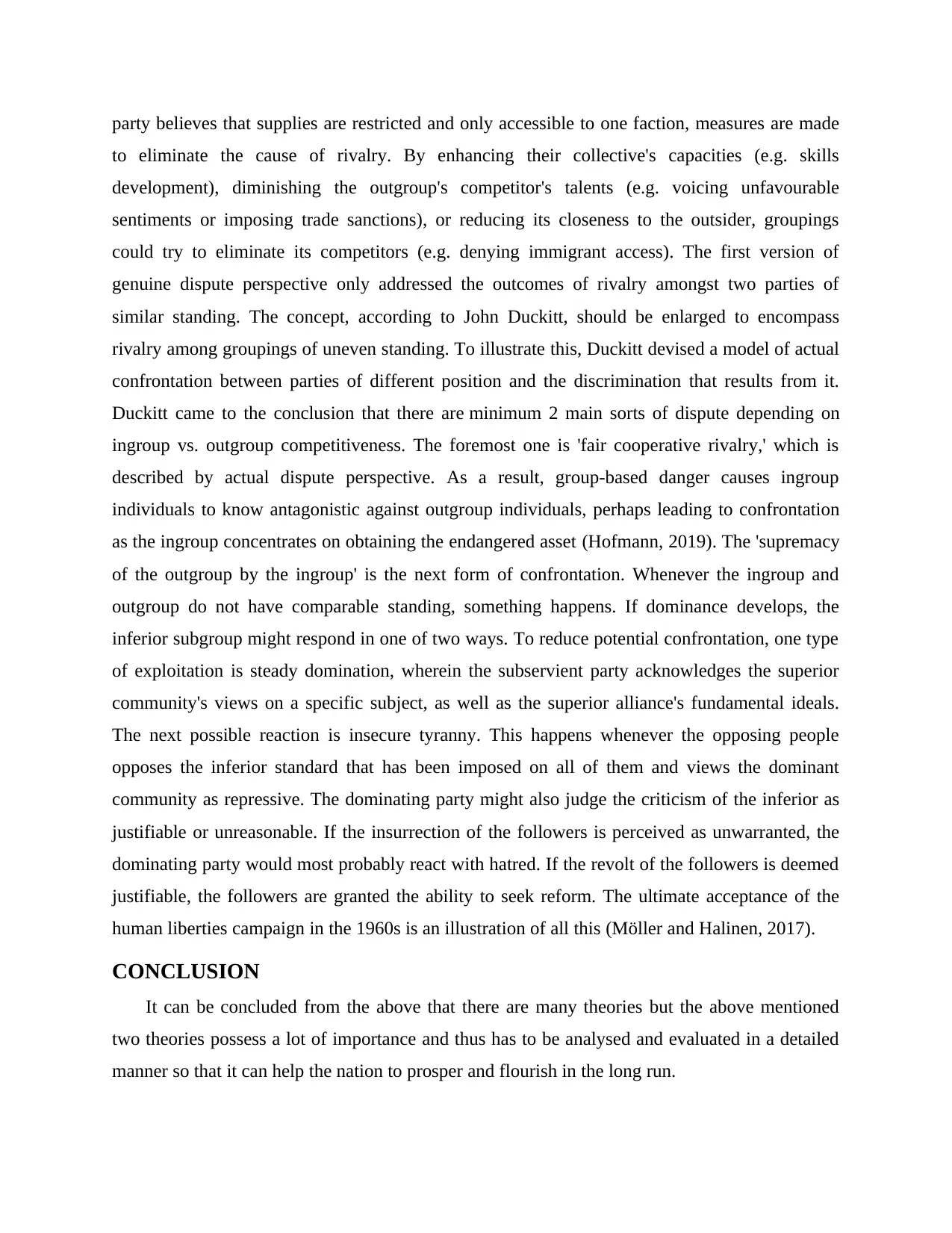
party believes that supplies are restricted and only accessible to one faction, measures are made
to eliminate the cause of rivalry. By enhancing their collective's capacities (e.g. skills
development), diminishing the outgroup's competitor's talents (e.g. voicing unfavourable
sentiments or imposing trade sanctions), or reducing its closeness to the outsider, groupings
could try to eliminate its competitors (e.g. denying immigrant access). The first version of
genuine dispute perspective only addressed the outcomes of rivalry amongst two parties of
similar standing. The concept, according to John Duckitt, should be enlarged to encompass
rivalry among groupings of uneven standing. To illustrate this, Duckitt devised a model of actual
confrontation between parties of different position and the discrimination that results from it.
Duckitt came to the conclusion that there are minimum 2 main sorts of dispute depending on
ingroup vs. outgroup competitiveness. The foremost one is 'fair cooperative rivalry,' which is
described by actual dispute perspective. As a result, group-based danger causes ingroup
individuals to know antagonistic against outgroup individuals, perhaps leading to confrontation
as the ingroup concentrates on obtaining the endangered asset (Hofmann, 2019). The 'supremacy
of the outgroup by the ingroup' is the next form of confrontation. Whenever the ingroup and
outgroup do not have comparable standing, something happens. If dominance develops, the
inferior subgroup might respond in one of two ways. To reduce potential confrontation, one type
of exploitation is steady domination, wherein the subservient party acknowledges the superior
community's views on a specific subject, as well as the superior alliance's fundamental ideals.
The next possible reaction is insecure tyranny. This happens whenever the opposing people
opposes the inferior standard that has been imposed on all of them and views the dominant
community as repressive. The dominating party might also judge the criticism of the inferior as
justifiable or unreasonable. If the insurrection of the followers is perceived as unwarranted, the
dominating party would most probably react with hatred. If the revolt of the followers is deemed
justifiable, the followers are granted the ability to seek reform. The ultimate acceptance of the
human liberties campaign in the 1960s is an illustration of all this (Möller and Halinen, 2017).
CONCLUSION
It can be concluded from the above that there are many theories but the above mentioned
two theories possess a lot of importance and thus has to be analysed and evaluated in a detailed
manner so that it can help the nation to prosper and flourish in the long run.
to eliminate the cause of rivalry. By enhancing their collective's capacities (e.g. skills
development), diminishing the outgroup's competitor's talents (e.g. voicing unfavourable
sentiments or imposing trade sanctions), or reducing its closeness to the outsider, groupings
could try to eliminate its competitors (e.g. denying immigrant access). The first version of
genuine dispute perspective only addressed the outcomes of rivalry amongst two parties of
similar standing. The concept, according to John Duckitt, should be enlarged to encompass
rivalry among groupings of uneven standing. To illustrate this, Duckitt devised a model of actual
confrontation between parties of different position and the discrimination that results from it.
Duckitt came to the conclusion that there are minimum 2 main sorts of dispute depending on
ingroup vs. outgroup competitiveness. The foremost one is 'fair cooperative rivalry,' which is
described by actual dispute perspective. As a result, group-based danger causes ingroup
individuals to know antagonistic against outgroup individuals, perhaps leading to confrontation
as the ingroup concentrates on obtaining the endangered asset (Hofmann, 2019). The 'supremacy
of the outgroup by the ingroup' is the next form of confrontation. Whenever the ingroup and
outgroup do not have comparable standing, something happens. If dominance develops, the
inferior subgroup might respond in one of two ways. To reduce potential confrontation, one type
of exploitation is steady domination, wherein the subservient party acknowledges the superior
community's views on a specific subject, as well as the superior alliance's fundamental ideals.
The next possible reaction is insecure tyranny. This happens whenever the opposing people
opposes the inferior standard that has been imposed on all of them and views the dominant
community as repressive. The dominating party might also judge the criticism of the inferior as
justifiable or unreasonable. If the insurrection of the followers is perceived as unwarranted, the
dominating party would most probably react with hatred. If the revolt of the followers is deemed
justifiable, the followers are granted the ability to seek reform. The ultimate acceptance of the
human liberties campaign in the 1960s is an illustration of all this (Möller and Halinen, 2017).
CONCLUSION
It can be concluded from the above that there are many theories but the above mentioned
two theories possess a lot of importance and thus has to be analysed and evaluated in a detailed
manner so that it can help the nation to prosper and flourish in the long run.
Secure Best Marks with AI Grader
Need help grading? Try our AI Grader for instant feedback on your assignments.
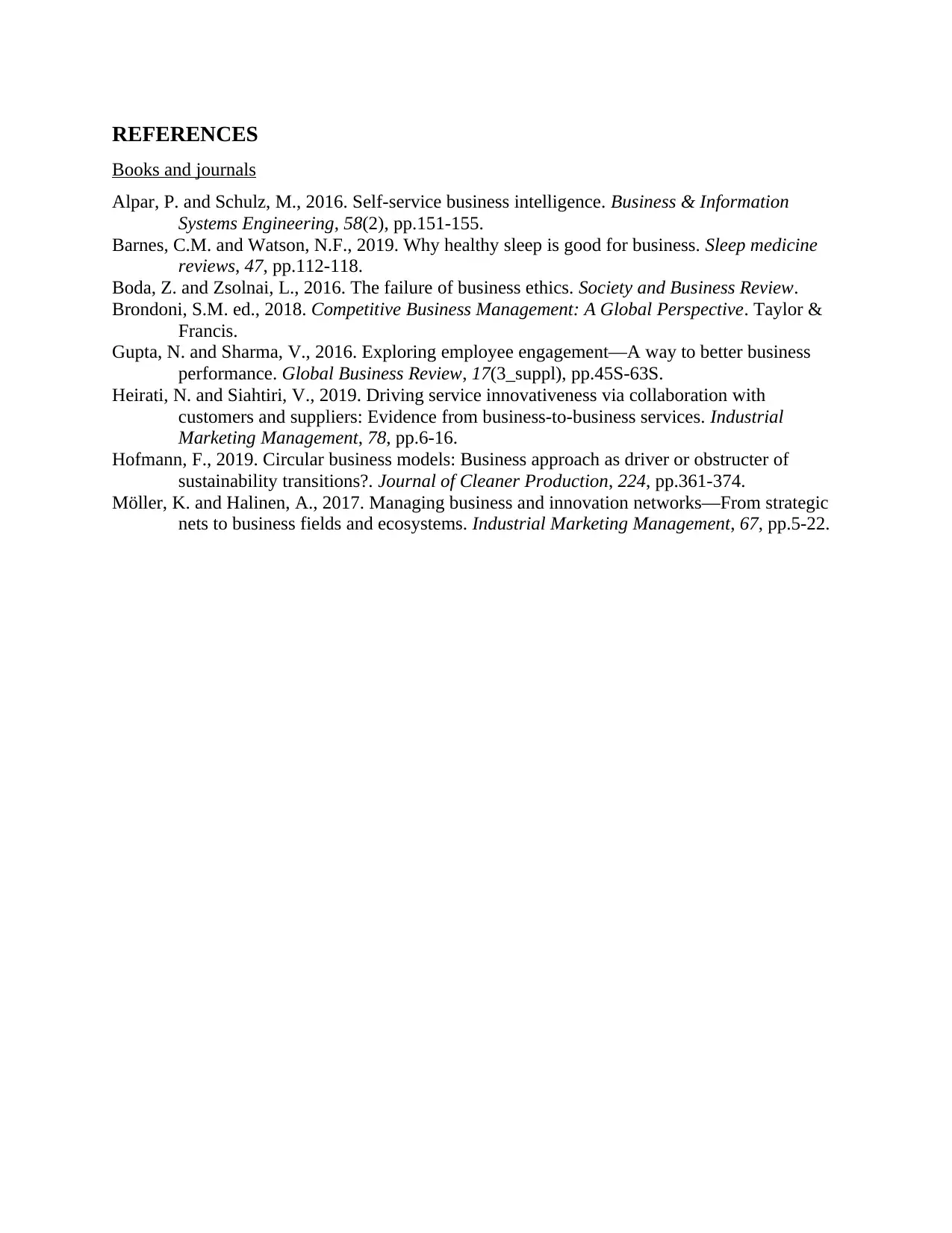
REFERENCES
Books and journals
Alpar, P. and Schulz, M., 2016. Self-service business intelligence. Business & Information
Systems Engineering, 58(2), pp.151-155.
Barnes, C.M. and Watson, N.F., 2019. Why healthy sleep is good for business. Sleep medicine
reviews, 47, pp.112-118.
Boda, Z. and Zsolnai, L., 2016. The failure of business ethics. Society and Business Review.
Brondoni, S.M. ed., 2018. Competitive Business Management: A Global Perspective. Taylor &
Francis.
Gupta, N. and Sharma, V., 2016. Exploring employee engagement—A way to better business
performance. Global Business Review, 17(3_suppl), pp.45S-63S.
Heirati, N. and Siahtiri, V., 2019. Driving service innovativeness via collaboration with
customers and suppliers: Evidence from business-to-business services. Industrial
Marketing Management, 78, pp.6-16.
Hofmann, F., 2019. Circular business models: Business approach as driver or obstructer of
sustainability transitions?. Journal of Cleaner Production, 224, pp.361-374.
Möller, K. and Halinen, A., 2017. Managing business and innovation networks—From strategic
nets to business fields and ecosystems. Industrial Marketing Management, 67, pp.5-22.
Books and journals
Alpar, P. and Schulz, M., 2016. Self-service business intelligence. Business & Information
Systems Engineering, 58(2), pp.151-155.
Barnes, C.M. and Watson, N.F., 2019. Why healthy sleep is good for business. Sleep medicine
reviews, 47, pp.112-118.
Boda, Z. and Zsolnai, L., 2016. The failure of business ethics. Society and Business Review.
Brondoni, S.M. ed., 2018. Competitive Business Management: A Global Perspective. Taylor &
Francis.
Gupta, N. and Sharma, V., 2016. Exploring employee engagement—A way to better business
performance. Global Business Review, 17(3_suppl), pp.45S-63S.
Heirati, N. and Siahtiri, V., 2019. Driving service innovativeness via collaboration with
customers and suppliers: Evidence from business-to-business services. Industrial
Marketing Management, 78, pp.6-16.
Hofmann, F., 2019. Circular business models: Business approach as driver or obstructer of
sustainability transitions?. Journal of Cleaner Production, 224, pp.361-374.
Möller, K. and Halinen, A., 2017. Managing business and innovation networks—From strategic
nets to business fields and ecosystems. Industrial Marketing Management, 67, pp.5-22.
1 out of 8
Related Documents
Your All-in-One AI-Powered Toolkit for Academic Success.
+13062052269
info@desklib.com
Available 24*7 on WhatsApp / Email
![[object Object]](/_next/static/media/star-bottom.7253800d.svg)
Unlock your academic potential
© 2024 | Zucol Services PVT LTD | All rights reserved.